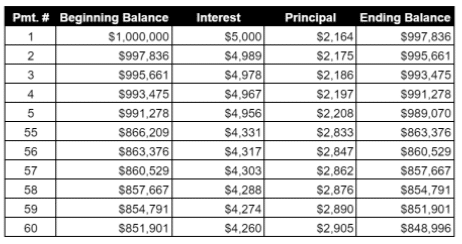Commercial real estate borrowing options frequently depend on a loan’s term and its amortization period. These features are often confused for each other, so it is the intent of this article to clear up the differences between a loan term vs. loan amortization, since they are important inputs into the loan payment calculation.
What is a Loan Term?
A loan’s “term” is the period of time that the borrower has to repay the principal balance. The term can vary from one loan to another and it is heavily influenced by two key factors:
- The specific needs of the transaction. For example, a borrower may plan to purchase a property, renovate it, and lease it up to stabilization. In such a case, the loan may have a shorter term than one that is intended to be held for a long period of time.
- How long the bank wants to commit to the transaction. Depending on their view of macroeconomic conditions and interest rate movements, a lender may or may not want to commit to a loan transaction for the long term.
In general, a commercial real estate loan has a term that ranges from 5-30 years, but most tend to be in the 5-10 year range. This is a relatively short term commitment for a lender and it provides borrowers with enough time to execute their business plan for the property.
What is Loan Amortization?
A loan’s amortization period is the amount of time over which a loan’s payments are calculated. In a commercial real estate transaction, it is common for a loan to have a “split amortization,” meaning that the loan’s term and amortization periods are different.
For example, a loan could have a term of five years, but the payments could be based on a 25-year amortization schedule. For the borrower, this has the benefit of a lower monthly payment to minimize cash outlay, but it also means that there is a “balloon payment” at the end of the term. A balloon payment is one that is much larger than the standard monthly payment and it typically consists of the remaining loan balance at the end of the loan term.
A loan’s amortization period can also vary from one transaction to the next, and it is chosen to accommodate the specific needs of the transaction. However, commercial real estate loan amortization periods typically fall within the range of 20-30 years. Once it is determined, an “amortization schedule” can be created that details exactly how much of each loan payment goes towards retiring the loan’s principal balance versus how much goes towards interest.
Calculating a Loan’s Payment and Amortization Schedule
Loan term and amortization are two of the four inputs that are needed to calculate a loan’s payment and create an amortization schedule. The other two inputs are the loan amount and the interest rate.
Example Payment Calculation
To illustrate how the loan term, amortization, amount, and interest rate work together, suppose a passive real estate investor is seeking a loan for $1,000,000. It has a 5 year term, an amortization period of 20 years, and an interest rate of 6%.
Rather than calculate the payment manually, these variables can be plugged into a financial calculator or spreadsheet program to calculate a payment amount of $7,164 per month. Translating this payment into an amortization schedule is a little bit more difficult.
Creating the Amortization Schedule
In the first month, the interest portion of the payment is calculated by multiplying the starting loan amount of $1,000,000 by the interest rate of 6%. The result of $60,000 indicates the amount of annual interest so it must be divided by 12 to get a monthly interest payment of $5,000. This means that in the first payment, $5,000 goes towards interest and the remaining $2,164 goes towards principal. After the first payment, the remaining loan principal is $997,836. This amortizing calculation continues for the entirety of the loan term, at which point the remaining balance is due as a balloon payment. The first 5 and last 5 payments are shown in the amortization table below.

From the table it can be seen that the amount of interest paid goes down a little bit each month and the amount of principal goes up. But, at the end of the loan term, month 60, the outstanding balance of $848,996 becomes due. This is the balloon payment and highlights the risk of a loan with a split amortization (versus a fully amortized loan). There are very few borrowers with this amount of cash to pay off the loan balance in full. As such, the best option is to refinance into a new loan, but there is no guarantee that this loan request will be approved.
Why the Loan Details Matter
It is important to understand the details of the loan transaction because they are an important input into the property’s proforma projection of cash flows. The mortgage payment must be forecast accurately for the entire length of time that the investment will be held to have an understanding of how much cash is available to be distributed to the property owner(s).
Interested In Learning More?
First National Realty Partners is one of the country’s leading private equity commercial real estate investment firms. With an intentional focus on finding world-class, multi-tenanted assets well below intrinsic value, we seek to create superior long-term, risk-adjusted returns for our investors while creating strong economic assets for the communities we invest in.
To learn more about our investment opportunities, contact us at (800) 605-4966 or ir@fnrpusa.com for more information.




